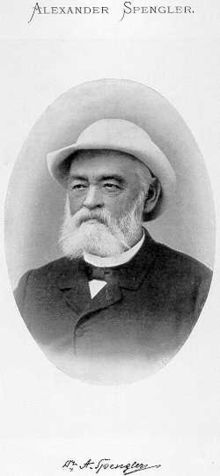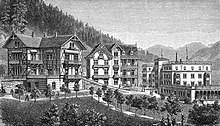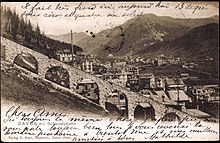Alexander Spengler
Alexander Spengler (born March 20, 1827 in Mannheim ; † January 11, 1901 in Davos ) was a German physician who emigrated to Switzerland for political reasons and assumed Swiss nationality.
Life
Spengler was born as the eldest son of Johann Philipp Spengler, a main teacher at the secondary school for girls in Mannheim.
From autumn 1846 he studied at the Ruprecht-Karls-University of Heidelberg five semesters of Law . In 1847 he became a member of the Corps Suevia Heidelberg . Like his Mannheim school colleagues Friedrich Hecker and Gustav von Struve, he took part in the March Revolution in 1848 and took over the leadership of the academic section. He took part in various skirmishes on the side of the revolutionary troops. In the last few days he has been appointed to General Franz Sigel's staff . After the defeat of the insurgents, he fled across the Swiss border near Säckingen to avoid arrest. He belonged to the minority of political refugees who were allowed to stay in Switzerland.
"One of the radicals wanted was this Spengler, a militant German traitor to the fatherland, hungry on top of that, who after the final failure of the European democracy movement in 1849 was barely able to save himself across the border ... that was the man who was supposed to found the mountain health resort Davos."
Spengler studied medicine at the University of Zurich . In 1853 he passed his exams and started looking for a job. On November 10, 1853, he signed a contract with the Davos region as a "landscape doctor", an official title at the time. He received 600 francs a year maintenance allowance and 85 cents for every patient visit during the day, double that at night. Davos was delighted to have a doctor again: in the past few decades the position was only filled irregularly; the landscape even decided to introduce a special tax in order to be able to shell out Spengler's salary.
“The beginning was tough. In wind and weather for hours on foot or on horseback through the high valley; the locals do not understand his dialect of Baden-Electoral Palatinate; He also lacks the stimulating atmosphere of Mannheim, Heidelberg or Zurich. "
The young doctor fell in love with Elisabeth Ambühl and wanted to marry her. She was the daughter of Andreas Ambühl, a confectioner and confectioner from Davos who got rich in St. Petersburg. For this a “home certificate” was necessary. The Grand Council confirmed his naturalization in June 1855. Spengler could not produce the required assets of 2,000 francs. Here the council was convinced that a doctor would certainly soon be able to do this; In any case, Spengler is an "appreciable acquisition for the local canton" . The wedding was celebrated on July 8, 1855.
Alexander Spengler married Elisabeth Ambühl on July 8, 1855 . They had two sons, Lucius Johann Alexander Spengler and Carl Rudolf Spengler, and three daughters, Ida Amalie Charlotte Peters geb. Spengler (1856–1935), Ursula Marie Emilie Spengler (1857–1872) and Maria Lenssen born. Spengler (1863-1922).
Spengler began to try out tuberculosis therapies. The first attempts with red Veltliner wine, a bed in the cowshed, where the patient should regain strength in the ammonia-laden air, failed. Spengler relied on the location of the place, around 1500 meters above zero.
He came to the conviction that the mountain climate of the area protected against tuberculosis and had a healing effect and he ensured that this view was spread.
In February 1865 the first winter spa guests, the doctor Friedrich August Unger and the bookseller Hugo Richter , arrived in Davos. They had cured unsuccessfully for a year in Brehmer's sanatorium in Görbersdorf and then became aware of Spengler.
Davos was not set up for winter guests. Only the Hotel Strela had heated guest rooms. The new guests got down there and, to the amazement of the local population, began to take cures on improvised bunk beds, as they had learned to do in Görbersdorf. They were looked after by Alexander Spengler and their condition improved surprisingly quickly, which confirmed Spengler's experience that the mountain climate of Davos has unimagined healing powers not only in summer but also in winter.
The healing of the two Görbersdorf patients became public and Spengler was able to write:
“In the summer of 1866, despite the unfavorable world situation, there were quite a few lung patients in Davos, with whom great successes were achieved; fifteen sick people decided to stay in the valley through the winter of 1866/67. "
In 1867 a special guest came: Willem Jan Holsboer . He became Alexander Spengler's most important colleague. Holsboer had gone to sea, worked his way up to become captain, later went to London and became a banker. In 1867 his young wife fell ill with a lung disease. He drove with her to Davos and had Alexander Spengler treat her. However, she died at the age of 20 in the same year. Holsboer stayed in Davos and got engaged to a local farmer's daughter in 1868. Their daughter should later become one of Spengler's daughters-in-law ...
While the winter spa business began with the two Germans in 1865, the Davoser Wochenblatt recorded 1,184 guests on December 31, 1885, including 484 Germans, 322 British, 92 Swiss, 84 Dutch, 38 Americans, 35 French, 29 Russians and 60 relatives of others Nations. At the turn of the century there were 600,000 overnight stays per year - the farmhouses in Davos-Platz have become a global health resort.
“Alexander Spengler withdrew from practice at the turn of the century; He died on January 11, 1901 at the age of 74 - "Nestor of the Davos doctors", as it was called in the Davos newspapers. "
Curhaus Spengler-Holsboer / Curhaus WJ Holsboer
Together with Willem Jan Holsboer, he opened the Spengler-Holsboer sanatorium in Davos in 1868 , the first larger facility in Davos, alongside small pensions, which introduced the open-air reclining cure for the treatment of pulmonary tuberculosis according to the principles of Hermann Brehmer and Peter Dettweiler in a moderate form. It blossomed immediately. It was originally a simple mountain inn, which was expanded by a transverse wing in 1871.
Holsboer became its head. Four years later, when the Kurhaus was fully occupied, it was destroyed by flames. Holsboer had a new, more modern house built on the foundation walls, the Curhaus WJ Holsboer , with a large glass gallery on the south side and a social room. Spengler took over the medical management again. He had withdrawn from his work as a landscape doctor.
A milk hall stood above the house. The guests could drink fresh milk there in the morning. Several villas (Villa Germania, Villa Britannia, Villa Wohlhotels, Villa Helvetia, Villa Piccola) were connected as dependencies with the main building or with each other through underground corridors or covered wall halls.
After the expansion in 1881 with a concert hall and corresponding stage facilities, the Curhaus became the social center of Davos. Up until the 1930s, concerts or theater were played here every day to give the sick a change in their monotonous everyday life. Knowing that some guests cannot stay in one place for long if they are not offered intellectual stimulation, Holsboer was the initiator of a permanent spa orchestra, a dedicated theater group and the organizer of many lectures. From 1915 these tasks were taken over by the newly founded Davos Art Society. Clara Schumann was a guest in the Curhaus Hall. Béla Bartók played the piano in this hall in 1927. A year later Albert Einstein played his violin in the same place and spoke at the opening of the Davos university courses .
Alexander House
He was committed to the poor throughout his life. In the 1860s he founded the Committee to Support Unmoved Lung Diseases. Since 1870, Spengler consulted deaconesses from Bern to look after them.
At the end of 1882, on the initiative of Alexander Spenglers, the Diakonissenhaus of the Protestant parish of Davos was founded for poor patients with free choice of doctor, which was later named Alexanderhaus in his honor . The Alexanderhaus and the Fridericianum school sanatorium were the only health resorts in Davos with strict house rules at this time.
His son Carl Spengler became head of the Alexanderhaus sanatorium and carried out research on tuberculosis and cancer. The immune body preparations he developed proved to be effective.
In 1889 Karl Turban opened the first closed tuberculosis sanatorium in the high mountains, the Turban Sanatorium.
Fridericianum around 1878
Exercise and diet
Alexander Spengler, like Hermann Brehmer in Görbersdorf, relied not only on lying cures, but also on exercise. He even had to defend himself against the accusation that he wanted to cure tuberculosis “only by climbing a mountain”. As an old gymnast and fencer, he insisted that with all the necessary rest, physical exercise was an important remedy. He prescribed cold showers, milk cures and a healthy diet. This included the Veltliner wine, consumed in moderation, and milk with cognac. In the end, tuberculosis was a nutritional disorder for him - as wrong as this diagnosis was, his cures often showed surprising results and at least brought the patient relief. Peter Dettweiler in Falkenstein also propagated a similar diet .
Spengler's avant-garde lust for sport did not let him rest beyond the sanatorium. In the 1870s he owned the first pair of Nordic skis in Davos. These skis are now in the Winter Sports Museum in Davos.
In the summer he climbed the mountains around the village with his sons and made sure that hiking trails were laid out and benches were set up.
English guests brought ice skating into fashion. Then there was ice hockey: Alexander Spengler's son Carl Spengler founded the international Spengler Cup for ice hockey in 1922 with the aim of “reuniting the youth of the nations at war in the First World War in sporting contacts”. The tournament takes place every year between St. Stephen's Day and New Year's Eve in the Davos ice rink.
Schatzalp sanatorium
The name Spengler is also associated with the Schatzalp . Willem Jan Holsboer planned the Schatzalp luxury sanatorium together with his sons-in-law Lucius Spengler and Eduard Neumann. With this building at an altitude of 1,865 meters, something unprecedented should be created. Far ahead of its time, the first flat roof was built on Schatzalp with a drainage through the inside of the house. Floor heating, running cold and hot water in every room were further innovations. A hydraulic elevator, a meteorological station, a funicular with direct current drive and electric light became standard.
The Schatzalp became groundbreaking for later sanatorium buildings and was a significant step towards modern architecture of the 20th century.
Lucius Spengler was chief physician in charge of the Schatzalp sanatorium until his death in 1923.
The Schatzalp in the magic mountain
In the Zauberberg , Thomas Mann mentions the Schatzalp nine times. A text example:
" The Schatzalp sanatorium is at the very top over there ... They have to move their corpses down there on a bobsleigh in winter, because then the paths are impassable ... ", Joachim Ziemßen explains to his cousin Hans Castorp.
To the Blauer Heinrich he says: Already on the drive from the train station to the Berghof Sanatorium, where Hans Castorp visits his sick cousin Joachim, he can take a look at the "flat, curly bottle made of blue glass with a metal cap". Joachim slips it straight back into his coat pocket, with the words: “Most of us have that up here. [...]. It also has a name with us, such a nickname, very jolly. ” Later, Hans Castorp learns this name from the mouth of the uneducated Ms. Stöhr: “ Without overcoming ”, says Thomas Mann,“ with a stubbornly ignorant expression, she brought the grumpy one Description "Der Blaue Heinrich" on the lips. "
literature
- Birte vom Brück: Alexander Spengler - pioneer of climate therapy. In: Deutsches Ärzteblatt . Vol. 101, H. 6 (February 6, 2004), pp. A-357, B-304, C-297.
- Armin Danco: The Yellow Book of the Corps Suevia zu Heidelberg, 3rd edition (members 1810–1985), Heidelberg 1985, No. 363
- Alfred Georg Frei : The man who invented Davos. In: The time . January 8, 2008.
- J. Ferdmann: The rise of Davos. 2nd Edition. Davos Revue, Davos 1990.
- Gerhard Saul: A corps student establishes Davos' international reputation: Dr. med. Alexander Spengler (Sueviae Heidelberg 1847, KCL 67, 360). In: then and now. 28, 195-202 (1983).
Web links
- Literature by and about Alexander Spengler in the catalog of the German National Library
- Peter Bollier: Spengler, Alexander. In: Historical Lexicon of Switzerland .
- Davos im Zauberberg (PDF; 7.5 MB)
- Medical Museum Davos (PDF; 7.8 MB)
- Blue Heinrich
Individual evidence
- ^ Kösener corps lists 1910, 72, 362
- ↑ a b c d Alfred Georg Frei : The man who invented Davos. In: The time . January 8, 2008.
- ^ Information from the Davos community, March 5, 2010
See also
| personal data | |
|---|---|
| SURNAME | Spengler, Alexander |
| BRIEF DESCRIPTION | Doctor and revolutionary |
| DATE OF BIRTH | March 20, 1827 |
| PLACE OF BIRTH | Mannheim |
| DATE OF DEATH | January 11, 1901 |
| Place of death | Davos |




















